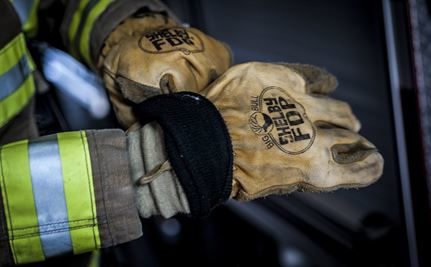Iowa State researchers to help firefighters

Courtesy of Joint Base Charleston
Iowa State is researching how to make the gloves used by firefighters and first responders easier and safer to use. Guowen Song, associate professor and the Noma Scott Lloyd chair in textiles and clothing, is leading the study.
November 11, 2019
Iowa State researchers are now working to make the job of firefighters safer.
Many gloves used by firefighters and other first responders are made of thick, bulky material designed to protect them. However, these materials can severely limit comfort and dexterity for firefighters and first responders, according to a recent study by Iowa State researchers.
Guowen Song is an associate professor of apparel, events and hospitality management and the Noma Scott Lloyd chair in textiles and clothing. Song is leading the study and finding ways to increase not only safety for firefighters’ equipment, but also comfort and dexterity.
A $1.5 million grant from the Department of Homeland Security and Federal Emergency Management Agency will allow Song and an interdisciplinary team of Iowa State researchers to work on the safety and function of heat-protection gloves as part of the personal protective equipment system for firefighters and other first responders.
“The current gloves are not really engineered to meet the basic requirements of protection, comfort and good manual performance,” Song said in a press release. “Firefighters lose more than 50 percent of their manual dexterity. With our combined expertise and advanced facilities, we can focus on these challenges and develop the next generation of personal protective equipment for better safety and health.”
The study is a collaborative effort with Iowa State researchers in textiles and clothing design; human physiology; numerical simulation; mechanical, chemical and biochemical engineering; performance evaluation and simulation; as well as fire departments and manufacturers.
Other members of the research team include Ellen McKinney and Chunhui Xiang, associate professor and assistant professor of apparel, events and hospitality management, respectively; Warren Franke and James Lang, professor and assistant professor of kinesiology, respectively; James Rossmanith, associate professor of mathematics; Lizhi Wang, associate professor of industrial and manufacturing systems engineering; Xinwei Wang, professor of mechanical engineering; and Daniel Russell, professor of human development and family studies.
The gloves are just the beginning for the team. In the next stage, researchers will be able to apply what they learn to other types of protective gear, such as boots and helmets, for firefighters and other emergency responders.
Using a sweating hand model, Song and others have conducted a series of experiments to measure how parts of the hand and fingers respond to heat, wind and cold. The database they created will be able to provide a foundation for the team’s work to develop a hand-specific thermal regulation model.
For example, the database shows how cold affects the forefinger and pinky finger differently. The researchers can use this information to select and design materials for the glove to maximize protection and comfort.
In a 2017 study published in Textile Research Journal, Song and his colleagues found the combination of moisture from sweating and heat interacting with different protective fabric systems can contribute to skin burn injuries — another factor to consider with the gloves.
The sweating hand model, developed in the Lab for Clothing Comfort Performance, sweats like a human hand, so researchers can test the performance of different textiles, materials and products.
The lab is also equipped with a full-size sweating mannequin to test for comfort with all types of protective gear. In the Lab for Heat and Thermal Protection Research, the researchers can test how textiles respond to various hazards including fire, hot liquid and steam.






